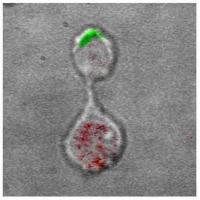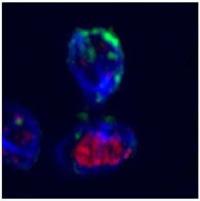
Listeria-specific T cell in final stages of cellular division. Using three dimensional microscopy, researchers were able to show how each new daughter cell inherited different types of proteins that regulate cell fate. Credit: John Chang, M.D., and Steven Reiner, M.D., University of Pennsylvania School of Medicine; Science How do immune cells decide to respond to invading microbes by either fighting to the death or becoming the body’s memory for future infections? Researchers at the University of Pennsylvania School of Medicine have discovered that immune cells can differ in their inheritance of molecules that regulate cell fate, and therefore what role they play in fighting infection. The research appears this week in an early online issue of Science.
"These findings will change the way we look at how vaccines work," says lead author Steven Reiner, MD, Professor of Medicine. "Until now, we have pretty much been in the dark as to how we generate the spectrum of immune cells that are needed to fight off infections. We've always known the end result – that more than one type of cell is needed – but not the initial events that generate cell diversity. Now we have information that may one day be applied to a more targeted approach to developing vaccines."
Immune cells first need to recognize infecting microbes, then divide and differentiate into the type of immune cells that fight off infection. But how, after replicating, do the new daughter cells know to become fighter cells that are expendable – in effect kamikazes – and yet reserve some cells to "remember" the invading microbe for future infections?
"That's the conundrum of the immune system and the extraordinary potential of a stem cell," explains Reiner. After the initial infection, some of the descendents of an immune cell reacting to a microbe must become the soldiers that fight the infection and die; but some, instead, regenerate to take the place of the mother cell, leaving an immunologic memory to recognize the invading microbe in the future.
Given the simplicity of this scenario, surprisingly few examples have been well-characterized that show how daughter cells can be different in their inheritance of molecules that regulate cell fate. The Science paper establishes how immune cells can achieve this asymmetric or unequal inheritance. 
Listeria-specific T cell in final stages of cellular division. Using three dimensional microscopy, researchers were able to show how each new daughter cell inherited different types of proteins that regulate cell fate. Credit: John Chang, M.D., and Steven Reiner, M.D., University of Pennsylvania School of Medicine; Science
The researchers studied the immune response to the bacteria Listeria in a mouse model. They transplanted T-cells specific to Listeria into the mice and then infected the mouse with Listeria. By extracting Listeria-specific T-cells from the mouses’ spleen and using a special dye label, the investigators were able to track the T-cells’ first divisions upon infection, telling the difference between the original mother T-cell and subsequent daughter cells.
In T cells on the verge of division, and which were the first responding to Listeria, the researchers tracked different types of molecules that each daughter cell retained after division. Proteins that regulate cell fate – whether to become the kamikaze T-cell or to stay like the mother cell and retain memory of the microbe invader – ended up in one or the other of the two of the daughter cells, but not both. "We saw a lopsided immune response within the first cell division," says Reiner.
Reiner and colleagues say that this line of research will change how scientists think about something as basic as how our bodies react to infection. "This will shock many immunologists because many of them think that when immune cells receive a signal, they all change one way or another, not in a way that makes two different daughter cells," says Reiner. "In terms of immunity and vaccines, we now understand how immune cells can generate this asymmetric cell fate." Source : University of Pennsylvania School of Medicine
 Print Article
Print Article Mail to a Friend
Mail to a Friend
